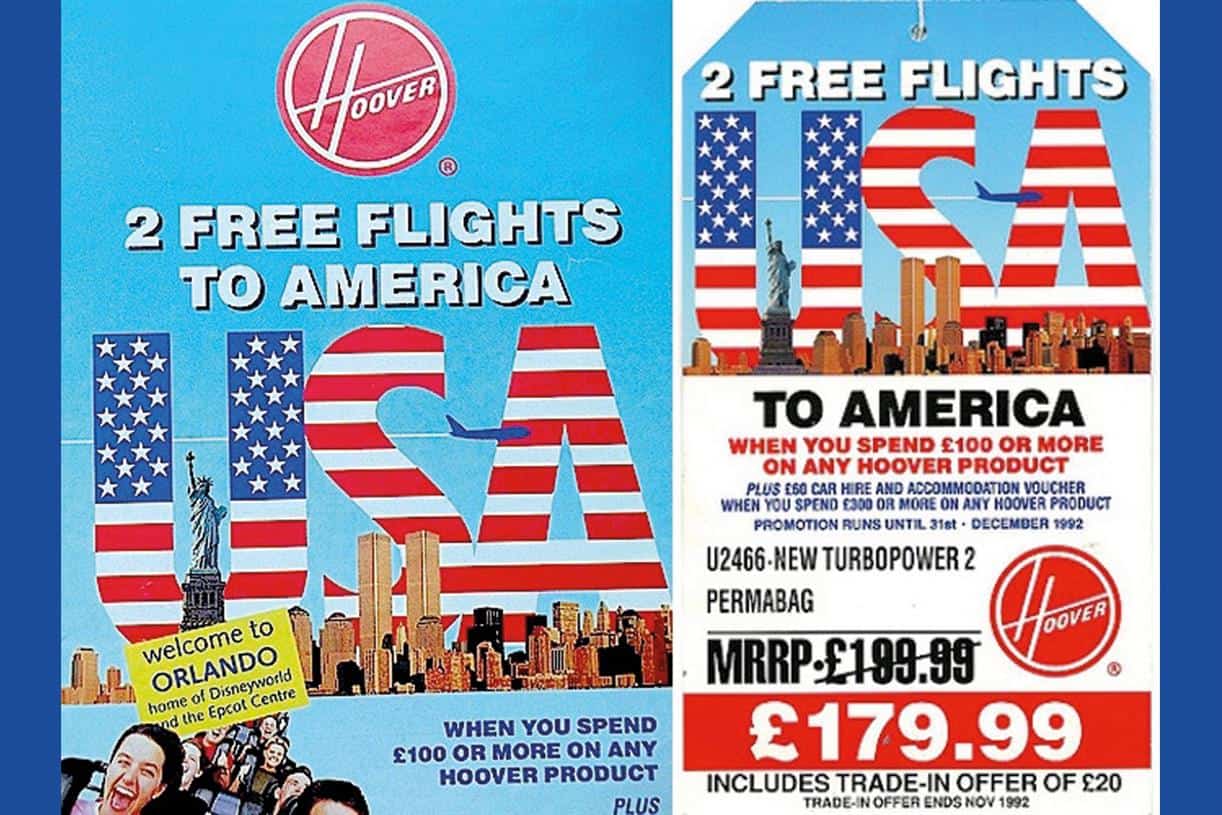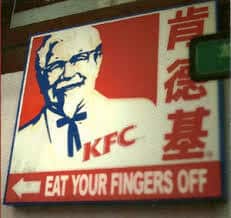We tasked our team with digging up the most disastrous, ill-conceived, or simply terrible creative and advertising campaigns in recent memory… the kind of work that belongs in a marketing crypt. The following are the campaigns that have earned a permanent, haunted spot in our graveyard.
In the early ‘90s, a global recession had hit the Hoover company hard. Sales were down and they needed to do something dramatic to arrest the decline. And in 1992 Hoover ran a ‘Free Flights’ promotion: spend £100 on a vacuum cleaner and get 2 free return flights to the USA (then worth about £600).
The company were warned that the financial risk was too great (they were even declined insurance cover because it didn’t add up) but they pressed on regardless, assuming that actual conversion would be low.
They were spectacularly mistaken.

When the promotion launched, sales of Hoover products went through the roof. Over 300,000 people purchased the qualifying products. It was a huge sales success. But soon dawned on Hoover that were now on the hook up 600,000 airline tickets.
The promotion generated £30m in sales. But the promotion was now going to cost the company £100m to fulfil, so they tried all kinds of underhand and unethical tactics to decline customers their tickets. News broke and disgruntled customers started taking action. One customer in Woking even held a Hoover delivery van hostage for 13 days. When it became apparent that not one flight ticket had been issued, the scandal made global headlines. Hoover was publicly disgraced. It was a financial and PR train wreck – a marketing disaster so catastrophic, it is still talked about today.
Eventually, over 200k customers did fly but over a hundred thousand never got their tickets. The legal challenges ran for years and the negative publicity was impossible to shake off. To make matters worse, second-hand Hoover products started flooding the market, so sales of new Hoovers collapsed. And in 1995 Hoover Europe was sold to Candy with losses of over $80m.
A genuine marketing horror story.
The most awful, misguided advertising campaigns are often those featuring celebrities happy to take the money and run. The sheer lack of authenticity is cringeworthy.
We’ve all seen a star compromise their carefully crafted image for a quick buck, and the resulting ads become instant residents of the campaign graveyard. Examples include:
Mariah Carey selling Walkers Crisps: She famously refused to eat them, and the resulting performance was a masterclass in visible disinterest.
Gordon Ramsay for Burger King: The celebrity chef compromised everything he stood for by taking a quick buck from the fast-food giant, sending confusing signals to his audience.
The Over-Saturation Effect: From Ant & Dec for Santander Bank and Suzuki and to Nicole Scherzinger flogging Muller yogurts these kind of celebrity endorsements risk making both the star and the brand feel generic and interchangeable.
At Halloween, some cats sit on broomsticks, other bigger cats can be found perched on a car. The Jaguar big cat was a big rebrand failure. Not only did it alienate loyal customers by abandoning recognisable brand elements, it failed to connect with a new audience too. Double scary!
This fright show was complete as the car rebrand launched with ads featuring… no cars! The backlash led to a significant drop in sales, with some reports citing a nearly 50% decrease between 2022 and 2024.
The rebrand, which dropped the leaping Jaguar logo for a minimalist nameplate and used abstract visuals, was seen by many as a disconnect from Jaguar’s heritage of performance and luxury. The campaign was titled ‘Copy Nothing’ – I suspect no-one will be copying this. A spectacular and spook-tacular disaster in equal measure.
This ad quickly became a cautionary legend. In a stunning piece of tone-deaf appropriation, the campaign attempted to co-opt social and political justice movements, culminating in Kendall Jenner solving a tense stand-off by handing a police officer a can of Pepsi. It trivialised activism, suggesting that deep societal conflict could be instantly resolved with a sugary drink and a celebrity gesture. The backlash was so immediate and universal that the campaign was pulled within 24 hours. A textbook failure in sensitivity and creative strategy.
Dove, a brand synonymous with celebrating ‘Real Beauty,’ stepped on a major landmine with a 2017 Facebook ad for body wash. The image showed a black woman removing her shirt to reveal a white woman. Despite the brand’s claims that the clip was taken out of context from a longer video, the isolated visual was seen by many as carrying racist connotations, suggesting the product ‘cleansed’ the skin from black to white. It demonstrates how a massive investment in brand reputation can be destroyed in a three-second clip due to a catastrophic failure of creative testing and cultural awareness. A three-second scare that haunts the brand to this day.
When brands go for a provocative headline, they risk destroying their intended message. A look at ads that used shocking tactics but failed spectacularly.

This wasn’t just a product launch, it was a slow-motion car crash of comms and strategy. In 1985, after extensive taste tests suggested consumers preferred a sweeter flavour, Coca-Cola made the fatal decision to discontinue the original formula and replace it with ‘New Coke’.
They fatally underestimated the deep emotional and cultural connection people had to the original product. The backlash was immense, leading to mass protests and, ultimately, the frenzied reintroduction of the original formula (renamed ‘Coca-Cola Classic’) just 79 days later. The ultimate proof that heritage and nostalgia trump mere taste.
The PR graveyard is littered with campaigns that were technically successful but tone-deaf. The spectacle of Katy Perry going into space on a commercial flight generated immediate negative press. At a time of global economic strain, this display of expensive, non-essential celebrity opulence felt deeply out of touch, cementing the narrative of billionaire excess and Hollywood disconnect.

For anyone who’s spent time grappling with another language, the sheer horror and accidental hilarity of a mistranslation is a thing to behold, and the KFC, Beijing, 1987 campaign immediately came to mind!
When the fast-food giant entered the Chinese market, it failed to adapt its famous, lip-smacking slogan. The iconic phrase, “Finger Lickin’ Good” was unfortunately translated into Chinese as “Eat Your Fingers Off”.
This spectacular failure in linguistic due diligence transformed a promise of deliciousness into a horrifying, if deeply funny, threat. It was a perfect storm of tunnel vision and a lack of basic language review that should serve as a stark warning to any global brand: what’s a tempting treat in one market can be a cannibalistic catastrophe in another.
Not every horror story is about a bad campaign; some are about the nightmare of execution. Before my time here at Maverick, I worked on a ‘Thriller’ film, and while a creative success, it was a production ordeal that still gives me cold sweats.
We were in a sticky pitch situation when the Creative Director suddenly blurted out, “or we could do Thriller with kids?”… a moment that sent a shockwave through the room.
Six weeks later, I found myself in Romania, having taken over a housing estate for all-night filming. The production was a tightrope walk of logistical chaos and real-life peril. Never work with children or animals? We had 15 (very talented) children and a wolf (that refused to howl), and, most memorably, a local gangster with a gun telling us to turn off the generator outside his house.
It’s a spectacular example of a great idea almost being destroyed by a perfect storm of technical, physical, and criminal interference. A content piece that worked brilliantly but only because we survived the shoot.
Our final entries are a trio of campaigns that earned their spots by trivializing human suffering, objectifying women, and exploiting a humanitarian crisis.
The stories from our Campaign Graveyard show that most marketing horrors aren’t born from malice, but from a fatal cocktail of tunnel vision, lack of sensitivity testing, and a belief that controversy automatically equals success.
Whether it’s the failure to understand deep-seated customer attachment (New Coke), the tragic misjudgement of social context (Pepsi and Jenner), or simply the compromising of a brand’s soul for a quick celebrity check (Mariah Carey for Walkers), the lessons are clear: The public is more savvy than ever, and authenticity is the most powerful shield against creative disaster.
Is your next campaign a potential masterpiece or a looming horror show? Get in touch with our strategy and creative teams to ensure your brand’s next move is brilliant, not buried.